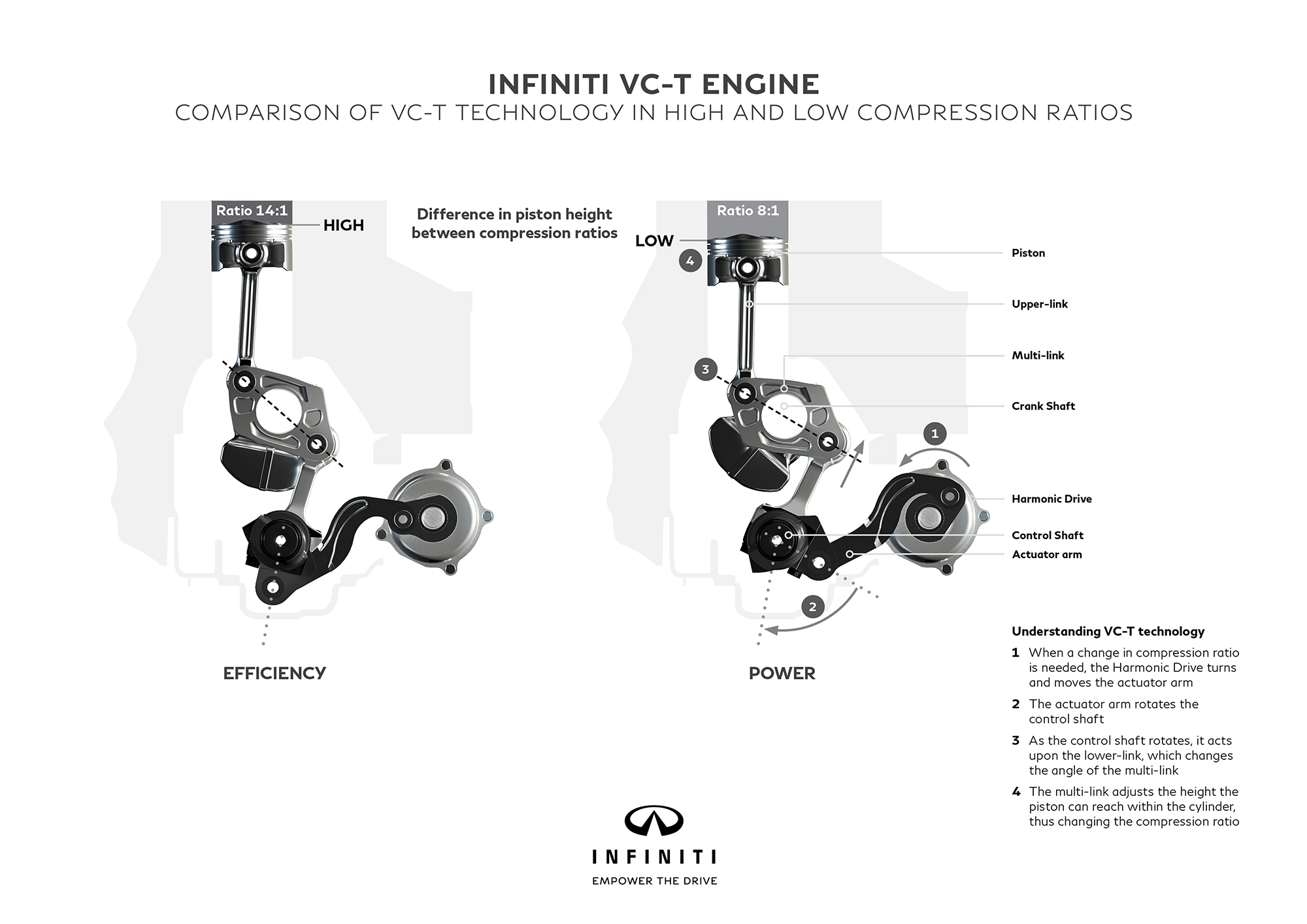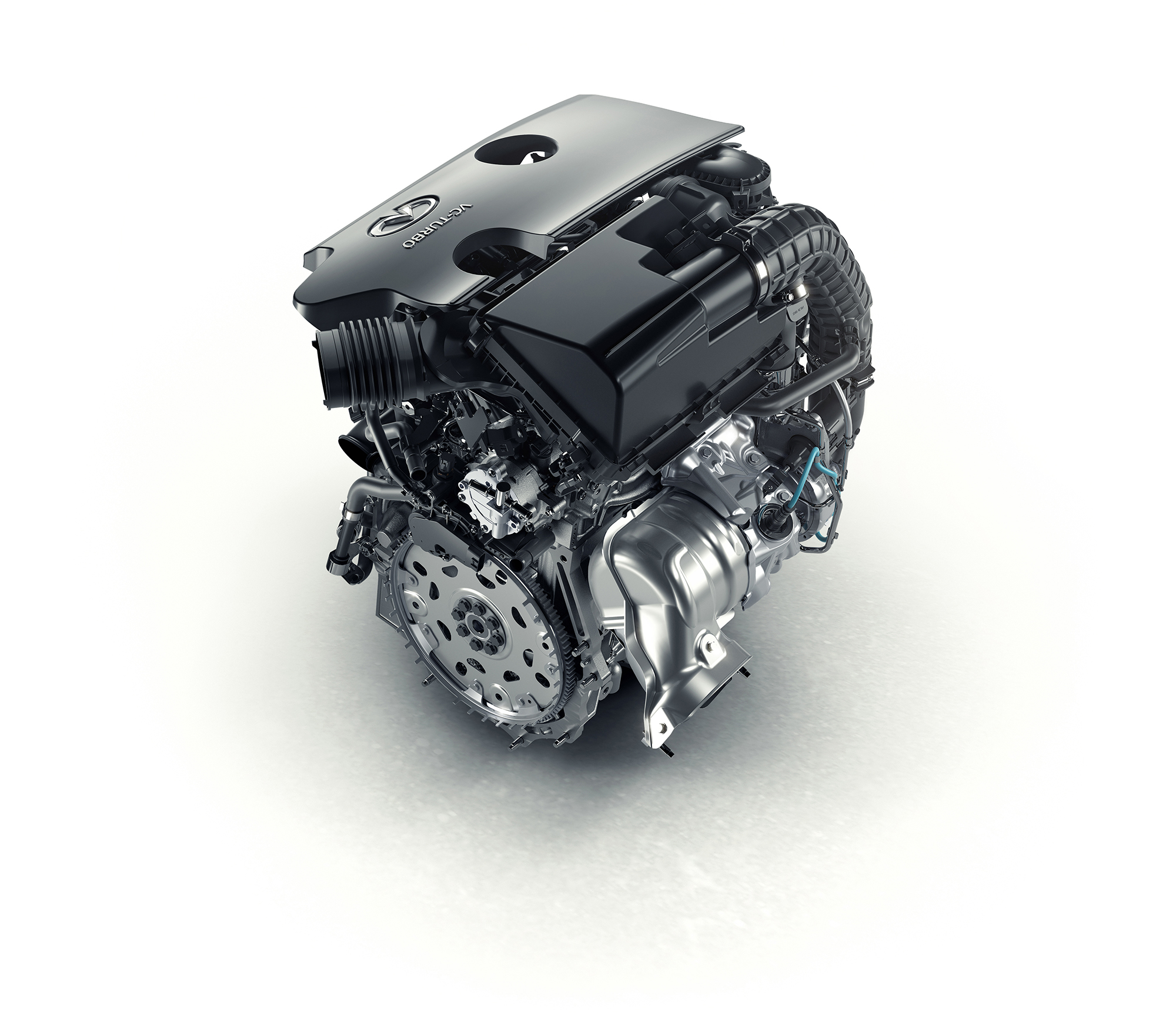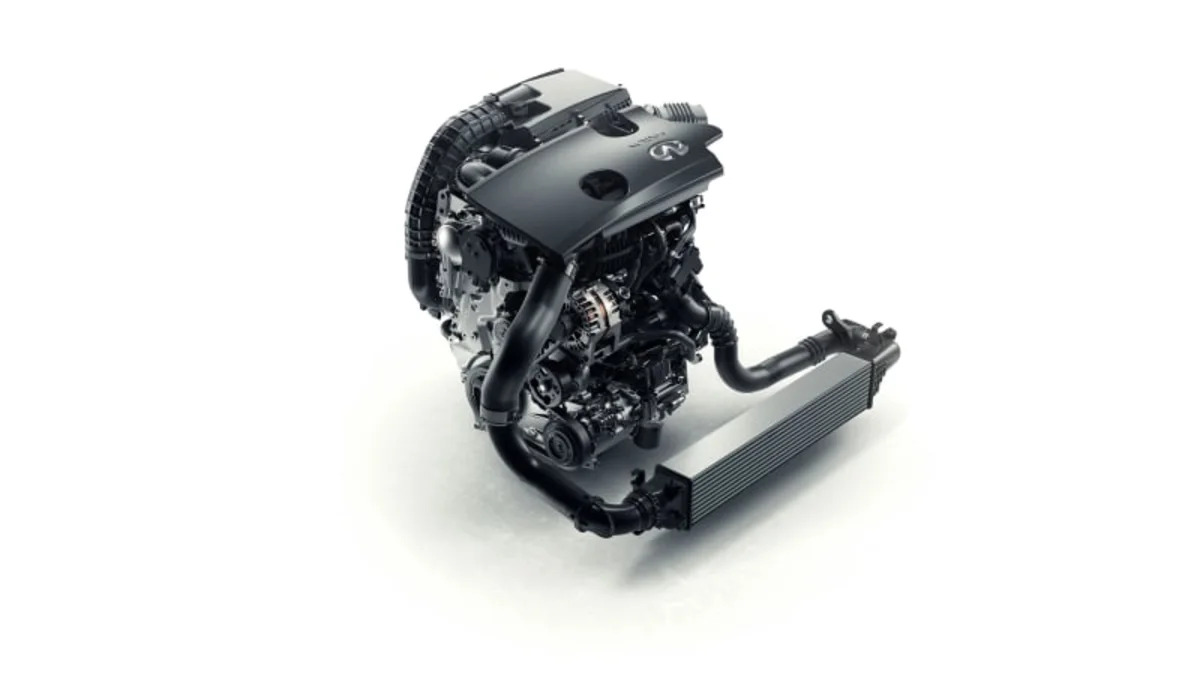The upcoming Infiniti QX50 crossover does not get our pulse racing, no matter how shapely the QX Sport Inspiration concept that previews it may be. No midsize SUV does, to be fair. But it has something special under the hood – the world's first production variable-compression-ratio engine. That means the QX50's 2.0-liter turbo four, which makes 268 horsepower and 288 pound-feet of torque, will have up to 27 percent better fuel economy. Here's how it works.
The trend of moving to smaller, turbocharged engines carries with it one big falsehood. Under low load when the turbo isn't needed, these engines are less efficient than an equivalent engine without a turbo because of the low compression ratio the turbo requires. That is, if you never need the extra power, you're wasting fuel.
Turbocharged (and supercharged) engines use a lower compression ratio to prevent detonation. When you force extra air in a cylinder and mix it with fuel, it's more likely to prematurely go boom. Lowering the compression ratio prevents this problem, but it's less efficient. Infiniti's VC-T promises the best of both worlds, with a compression ratio that ranges from 8.0:1 for high-power turbo needs to a 14.0:1 ratio for fuel-sipping efficiency.
At its heart the VC-T engine is a simple idea, but it's complicated to explain. Consider yourself warned. The photo below from Infiniti serves as a good visual overview. For the truly nerdy, this patent application covers the mechanical concept.

Instead of having the pistons connected to the crankshaft, Infiniti's engine has a pivot arm with a connection on each end. One end connects to the piston, the other connects to a second lower shaft, which is controlled by an actuator arm. At any given time the engine's pistons move up and down according to the lobes on the crankshaft. But the actuator arm can change the angle of the pivot arm up and down. That is, the pistons still move in the same motion with the same stroke, but phase the entire stroke up or down. Move the pivot up and there's less room at the top, which means a higher compression ratio. Move the pivot down and the compression ratio goes down, too. As an added bonus, the lower shaft eliminates the need for counter-rotating balance shafts.
Infiniti says this system works constantly and can vary the compression ratio to any number between 8:1 and 14:1. It also uses electronic variable valve timing on the intake valves to switch into Atkinson-cycle combustion for greater efficiency. The exhaust valve uses a more common oil pressure-based cam phaser. Other nifty features include a cylinder head with integrated exhaust manifold, electronic wastegate control for the turbo, and a variable-displacement oil pump. Both port and direct fuel injection are used as well.
The VC-T engine offers more power and torque than the standard 2,0-liter turbo four offerings from Audi, BMW, and Mercedes-Benz. It also beats the 2.0-liter in the Chinese-market Cadillac XT5 on horsepower. There are more powerful turbo engines of this size found under the hoods of cars like the Honda Civic Type-R, Mercedes-Benz CLA45 AMG and GLA45 AMG, and Subaru Impreza WRX and STI (to name a few). But Infiniti's claim here is a better combination of efficiency and power. Expect the VC-T to be paired with a CVT in the QX50.

Infiniti says that the variable-compression-ratio technology can be scaled to other sizes of four-cylinder engines, but is impractical for V6 and V8 engines. Speaking of V6s, the power and torque of the VC-T is right in line with the 3.5-liter VQ used in the QX60 and various front-wheel-drive Nissans. Like those vehicles, the VC-T in the QX50 will be mounted transverse but offer some form of all-wheel drive. It's easy to see this engine taking over for the VQ in any of its current Nissan applications.
For the near future, the VC-T will be exclusive to the QX50, production of which starts in 2017. Dropping this engine in the rear-drive Q60 might have been more buzz-worthy, but Nissan (and Infiniti) chose a more pragmatic plan. The transverse setup guarantees more widespread adoption, spreading the cost and corporate fuel-economy benefits over a wider area. Putting all that aside, the VC-T is an amazing piece of groundbreaking technology. Amazing enough that, yes, Infiniti has us excited for a midsize SUV.
Related Video:

The trend of moving to smaller, turbocharged engines carries with it one big falsehood. Under low load when the turbo isn't needed, these engines are less efficient than an equivalent engine without a turbo because of the low compression ratio the turbo requires. That is, if you never need the extra power, you're wasting fuel.
Turbocharged (and supercharged) engines use a lower compression ratio to prevent detonation. When you force extra air in a cylinder and mix it with fuel, it's more likely to prematurely go boom. Lowering the compression ratio prevents this problem, but it's less efficient. Infiniti's VC-T promises the best of both worlds, with a compression ratio that ranges from 8.0:1 for high-power turbo needs to a 14.0:1 ratio for fuel-sipping efficiency.
At its heart the VC-T engine is a simple idea, but it's complicated to explain. Consider yourself warned. The photo below from Infiniti serves as a good visual overview. For the truly nerdy, this patent application covers the mechanical concept.
Instead of having the pistons connected to the crankshaft, Infiniti's engine has a pivot arm with a connection on each end. One end connects to the piston, the other connects to a second lower shaft, which is controlled by an actuator arm. At any given time the engine's pistons move up and down according to the lobes on the crankshaft. But the actuator arm can change the angle of the pivot arm up and down. That is, the pistons still move in the same motion with the same stroke, but phase the entire stroke up or down. Move the pivot up and there's less room at the top, which means a higher compression ratio. Move the pivot down and the compression ratio goes down, too. As an added bonus, the lower shaft eliminates the need for counter-rotating balance shafts.
Infiniti says this system works constantly and can vary the compression ratio to any number between 8:1 and 14:1. It also uses electronic variable valve timing on the intake valves to switch into Atkinson-cycle combustion for greater efficiency. The exhaust valve uses a more common oil pressure-based cam phaser. Other nifty features include a cylinder head with integrated exhaust manifold, electronic wastegate control for the turbo, and a variable-displacement oil pump. Both port and direct fuel injection are used as well.
The VC-T engine offers more power and torque than the standard 2,0-liter turbo four offerings from Audi, BMW, and Mercedes-Benz. It also beats the 2.0-liter in the Chinese-market Cadillac XT5 on horsepower. There are more powerful turbo engines of this size found under the hoods of cars like the Honda Civic Type-R, Mercedes-Benz CLA45 AMG and GLA45 AMG, and Subaru Impreza WRX and STI (to name a few). But Infiniti's claim here is a better combination of efficiency and power. Expect the VC-T to be paired with a CVT in the QX50.

Infiniti says that the variable-compression-ratio technology can be scaled to other sizes of four-cylinder engines, but is impractical for V6 and V8 engines. Speaking of V6s, the power and torque of the VC-T is right in line with the 3.5-liter VQ used in the QX60 and various front-wheel-drive Nissans. Like those vehicles, the VC-T in the QX50 will be mounted transverse but offer some form of all-wheel drive. It's easy to see this engine taking over for the VQ in any of its current Nissan applications.
For the near future, the VC-T will be exclusive to the QX50, production of which starts in 2017. Dropping this engine in the rear-drive Q60 might have been more buzz-worthy, but Nissan (and Infiniti) chose a more pragmatic plan. The transverse setup guarantees more widespread adoption, spreading the cost and corporate fuel-economy benefits over a wider area. Putting all that aside, the VC-T is an amazing piece of groundbreaking technology. Amazing enough that, yes, Infiniti has us excited for a midsize SUV.
Related Video:



Sign in to post
Please sign in to leave a comment.
Continue